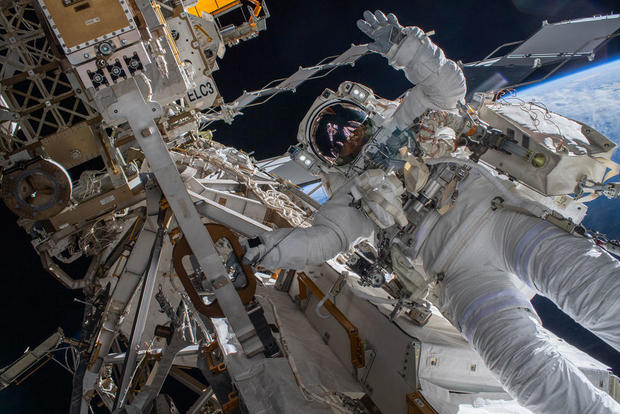The aging shuttle-era spacesuits aboard the International Space Station have been declared "no-go" for operational, normally planned spacewalks, pending analysis to determine what led to excess water getting into an astronaut's helmet during a March excursion, officials confirmed Tuesday.
But the bulky spacesuits — "extra-vehicular mobility units," or EMUs — can still be used for emergency repairs or to resolve other unexpected issues if agency managers agree after assessing the overall risk.
"Until we understand better what the causal factors might have been during the last EVA with our EMU, we are no-go for nominal EVA (spacewalk)," said Dana Weigel, deputy manager of the space station program at the Johnson Space Center in Houston. "So we won't do a planned EVA until we've had a chance to really address and rule out major system failure modes."
Water intrusion has been a source of concern ever since a July 2013 spacewalk in which European Space Agency astronaut Luca Parmitano's helmet flooded with water, a frightening, potentially life-threatening malfunction that forced an early end to the excursion.
Parmitano was not injured, but after the spacewalk NASA said he reported "impaired visibility and breathing with water covering his eyes, nose and ears." The astronaut's "calm demeanor in the face of his helmet filling with water possibly saved his life."
The "high-visibility close call" triggered a major investigation to pin down the source of the leakage. A detailed inspection revealed clogs in a component that inadvertently diverted water into a vent line that allowed intrusion into the helmet.
While working to resolve suit servicing to prevent such clogs in the future, NASA implemented two steps to help a spacewalker make it back to the station's airlock in a similar emergency.
A "helmet absorption pad," or HAP, is now placed at the back of the helmet to soak up any excess water that might make its way into the headpiece and a separate straw-like breathing tube was added to provide an unobstructed supply of air if needed. Astronauts now report the status of their HAPs throughout a spacewalk.
More recently, Weigel said, another absorbent pad has been added to form a dam of sorts, impeding the movement of any water toward the front of the helmet.
There have been no serious instances of water intrusion since Parmitano's spacewalk, but at the end of the most recent EVA on March 23, astronaut Kayla Barron, helping German astronaut Matthias Maurer out of his spacesuit, found water inside the helmet.
"It's a little bit difficult to judge the volume because it's spread across the front of his visor," Barron said. "But I think we should accelerate the steps to get him out of his suit here."
Once the helmet was off, the crew estimated up to 50 percent of the visor was coated with a thin film of water and that the absorption pad at the back of the helmet was damp.
"The HAP is a little bit moist, but I think it would have been difficult to detect through a comm(unication) cap," Barron reported. "Roughly, maybe an eight- to 10-inch diameter circle, a thin film of water on the helmet. And there is water in his vent port at the back of his neck ring."
NASA plans to send Maurer's EMU back to Earth in July aboard a SpaceX Dragon cargo ship for an engineering analysis.
Four spacewalks to continue upgrading the station's solar power system had been tentatively planned over the rest of the year, two in August and two in November, but such EVAs are now on hold pending analysis of Maurer's suit.
"So far, we haven't found anything unusual," Weigel said of inspections aboard the space station. "We're looking for any obvious signs of contamination or fouling or something else that might have gotten into our system. We're not seeing that yet."
While planned spacewalks are on hold, she said a contingency EVA could be approved after review and a "risk-versus-risk" assessment.
"Depending upon what has failed and what the risk is to the spacecraft and to the mission overall, we'll look at where we are with the investigation, where we are with the additional mitigations that we're putting in place and we'll specifically make a call based on the contingency and where we are at the given moment," she said.
Spacesuits aboard station declared a "no-go" pending analysis of recent helmet water leak - CBS News
Read More



No comments:
Post a Comment